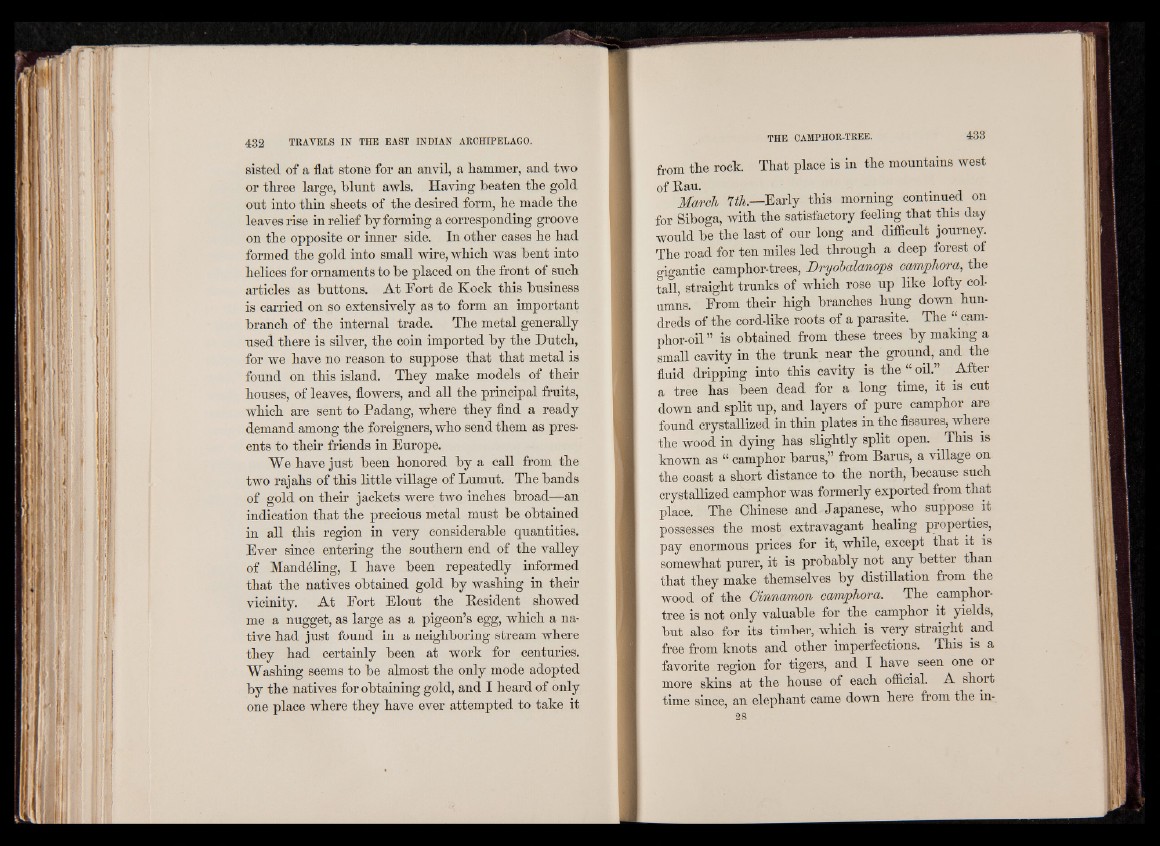
sisted of a flat stone for an anvil, a hammer, and two
or three large, blunt awls. Having beaten the gold
out into thin sheets of the desired form, he made the
leaves rise in relief by forming a corresponding groove
on the opposite or inner side. In other cases he had
formed the gold into small wire, which was bent into
helices for ornaments to be placed on the front of such
articles as buttons. At Fort de Kock this business
is carried on so extensively as to form an important
branch of the internal trade. The metal generally
used there is silver, the coin imported by the Dutch,
for we have no reason to suppose that that metal is
found on this island. They make models of their
houses, of leaves, flowers, and all the principal fruits,
which are sent to Padang, where they find a ready
demand among the foreigners, who send them as presents
to their friends in Europe.
We have just been honored by a call from the
two rajahs of this little village of Lumut. The bands
of gold on their jackets were two inches broad—an
indication that the precious metal must be obtained
in all this region in very considerable quantities.
Ever since entering the southern end of the valley
of Mandeling, I have been repeatedly informed
that the natives obtained gold by washing in their
vicinity. At Fort Elout the Resident showed
me a nugget, as large as a pigeon’s egg, which a native
had just found in a neighboring stream where
they had certainly been at work for centuries.
Washing seems to be almost the only mode adopted
by the natives for obtaining gold, and I heard of only
one place where they have ever attempted to take it
from the rock. That place is in the mountains west
of Rau. t
March 7th.—Early this morning continued on
for Siboga, with the satisfactory feeling that this day
would be the last of our long and difficult journey.
The road for ten miles led through a deep forest of
gigantic camphor-trees, Dryobalcmops camphora, the
tall, straight trunks of which rose up like lofty columns.
From their high branches hung down hundreds
of the cord-like roots of a parasite. The “ cam-
phor-oil ” is obtained from these trees by making a
small cavity in the trunk near the ground, and the
fluid dripping into this cavity is the u oil. After
a tree has been dead for a long time, it is cut
down and split up, and layers of pure camphor are
found crystallized in thin plates in the fissures, where
the wood in dying has slightly split open. I This is
known as “ camphor barus,” from Barus, a village on
the coast a short distance to the north, because such
crystallized camphor was formerly exported from that
place. The Chinese and Japanese, who suppose it
possesses the most extravagant healing properties,
pay enormous prices for it, while, except that it is
somewhat purer, it is probably not any better than
that they make themselves by distillation from the
wood of the Cirmamon camphora. The camphor-
tree is not only valuable for the camphor it yields,
but also for its timber, which is very straight and
free from knots and other imperfections. This is a
favorite region for tigers, and I have seen one or
more skins at the house of each official. A short
time since, an elephant came down here from the in-
28